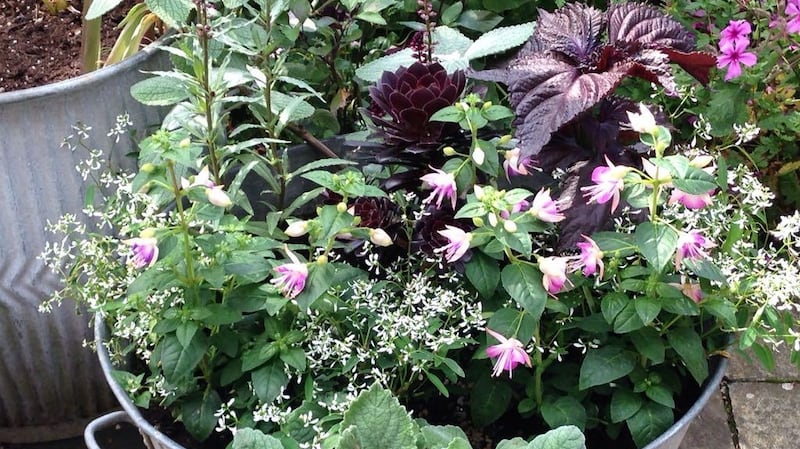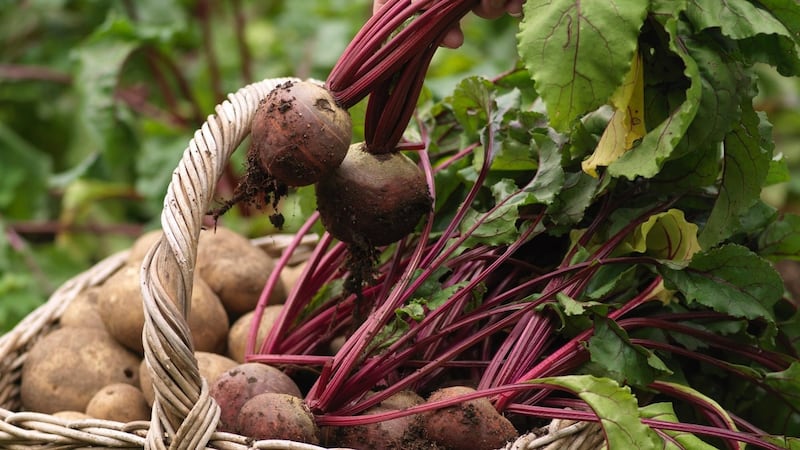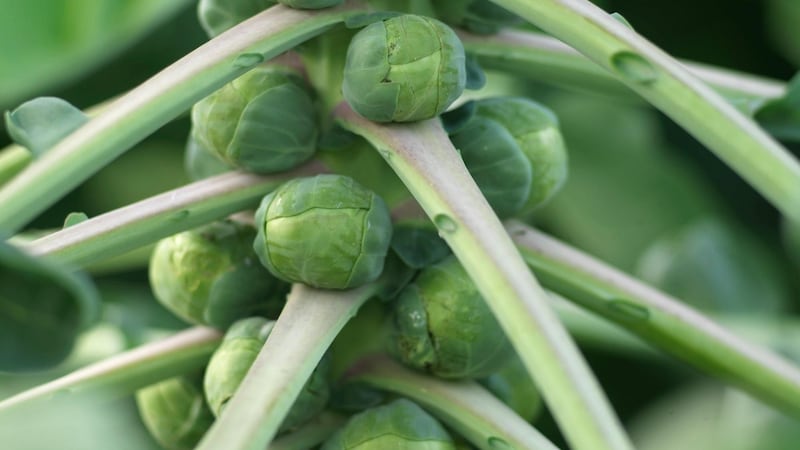It’s that time of year again when Ireland’s garden centres, hardware stores and supermarket chains are filled with cheery displays of annual bedding plants brimful of colour, entreating you to buy them. Hot pink surfinias, begonias the colour of lemon drops, sweet-smelling stock, popsicle-coloured pelargoniums, sherbety cosmos, fruit-gum coloured osteospermums, cascades of peacock-blue lobelias, violet verbenas . . .
If you’re new to the world of gardening, it can feel a little like walking into a sweetshop, while even seasoned gardeners find it difficult to restrain themselves from gorging on all that high-octane colour, especially when it comes with the whispered promise of long, hot summer days filled with picnics and barbequeues. But hold your horses, as just a little careful planning will make all the difference to the quality, floriferousness and longevity of those much longed-for displays of summer colour.
Containers
Let’s start with the containers, which should be as large and as splendid as you can manage. Not only will a few out-sized pots or urns add much-needed visual ballast, unity and coherence to any summer display, they’ll also make the job of keeping your plants well fed and watered a whole lot easier than if you were growing them in half a dozen smaller pots. By large, I mean at least 60cm (2 feet) in diameter and at least 30-60cm in height.
Where to get them? Wicklow-based Dunne & Dineen supply Irish garden centres with an extensive selection of garden containers including the lovely Impruneta range (among BBC gardener Monty Don's favourites), which Marcus Dunne describes as the "crème de la crème" of garden pots. Handmade to old Italian designs and frost-resistant to temperatures of -12C (so they can be re-used for spring-flowering bulbs), these are beautiful in their own right. But they're not cheap (from €100-€300, available in many good Irish garden centres). More affordable options include Weather Wise Clay Range (frost-resistant to temperatures as low as -25C) while the company's range of granite-clay style pots are also increasingly popular (dunneanddineen.ie). Wexford-based Kiltrea Bridge Pottery (kiltreapottery.com) and Kerry-based Louis Mulcahy Pottery (louismulcahy.com) also supply lovely ranges of garden pots designed specifically for outdoor use.
Next, let’s talk about the growing medium. This needs to be fresh (so definitely not last year’s tired, spent compost), rich in plant nutrients (important when you’re growing so many plants cheek-by-jowl), and moisture-retentive yet free-draining. You could use some good quality homemade garden compost mixed with a little good topsoil and coarse horticultural grit (available from good garden centres) , or get yourself a few bags of good quality John Innes-type compost enriched with some extra horticultural grit and a handful or two of slow-release pelleted organic fertiliser. Add some broken pieces of polystyrene board to the very bottom of the pot before filling it, to save on compost and help with drainage.

Peak condition
Now let’s talk about the plants themselves. Resist the urge (one that almost all kind-hearted gardeners suffer from) to buy any woefully neglected trays of water-deprived, wilted plants in the hope of resuscitating them. This sort of compassionate horticultural A&E may be fine when it comes to other kinds of longer-lived plants – shrubs, trees, even perennials – but time is of the essence when it comes to making the most of what short-lived annuals have to offer. Instead restrict yourself to specimens that are in peak condition (dark green, healthy leaves, none/ very few faded flowers, lots of flower buds, no signs of being pot bound) and have been kept well-watered and fed (so no dry or shrunken compost).
Next, let’s talk about putting together a display that will be visually beautiful, long-lasting, floriferous and easy to maintain. Begin by deciding on a colour scheme and a theme – it might fiery and tropical, for example, or romantically pastel, or richly gothic – and stick to it.
But don’t feel you have to stick solely to annuals. There are oodles of hardworking perennials including hardy geraniums, astrantias, salvias and geums that can be usefully incorporated into a summer container display. In fact, many supposed annual bedding plants (examples include fuchsias, argyranthemums/ marguerites, tuberous begonias, dahlias, chocolate cosmos, plectranthus), can be overwintered in a frost-free glasshouse or garden shed to be re-used for years to come.
Always bear in mind the importance of foliage interest. By their nature flowers are ephemeral while the leaves of handsome foliage plants such as the silvery Plectranthus argentatus, Cineraria 'Dusty Miller', wine-red perilla, fleshy aeoniums, cannas, ornamental grasses, persicarias and various varieties of coleus in all their fruity, zingy colours and zebra-stripes will give you many months of interest. For example, one of the favourite combinations of Cork gardener Hester Forde, who is well-known for her sophisticated container displays of summer colour, includes the fleshy Aeonium 'Schwarzkopf', silver-purple Lysimachia 'Beaujolais', silver-plum leafed Astelia 'Red Devil', Plectranthus argentatus, the tumbling Plectranthus hadiensis var. tomentosus, pale-pink fuchsias and Euphorbia 'Diamond Frost', all planted together in a large and handsome zinc tub..
Close planting
When it comes to planting up your summer pots, forget the normal rules regarding plant spacing and instead plant much more closely (15-20cm apart), but keep in mind the eventual height of the different species or varieties. I also find it useful to soak the plants’ root-balls in a diluted liquid seaweed feed just prior to planting. Remember, too, that almost all traditional annual bedding plants require a sheltered spot in full sun (the few exceptions include busy lizzies, trailing fuchsias and begonias) so don’t plonk your pots in a cool, shady corner where they will languish. Similarly, if you garden in one of the colder parts of the country, hold off planting until the end of this month or make sure to keep your freshly-planted container protected from cold nights, Once planted, water generously, take careful precautions against slugs/ snails and keep plants well-watered and regularly fed (aim for a liquid feed every 10-14 days). Regular deadheading is also vital for a wonderfully floriferous and colourful display that will continue until the first harsh frosts of autumn.

This week in the garden
Lovely lilacs
Mid to late May is lilac time, when these hardy shrubs (Syringa vulgaris) are typically at their floriferous and most fragrant best in Irish gardens. While container-grown lilacs can be planted in the garden at any time of the year, it's always a good idea to buy them from a garden centre while they're in flower as this way you can be absolutely sure you're getting the variety of your choice. A wide range of cultivars are generally available, including the lovely white-flowered Syringa 'Madame Lemoine', the mauve-flowered Syringa 'Charles Joly' and the pale lavender 'Syringa 'Katherine Havemeyer', all of which reach an average eventual height and spread of 6-7m. More compact forms are also available for smaller gardens which reach an average height and spread of just 1.25-1.5m including the Syringa 'Flowerfesta' series (available in pink, purple and white) and Syringa 'Red Pixie'. All lilacs like a moisture-retentive well-drained, fertile neutral to alkaline soil in full sun or light shade.
Sweet pea If you planted your sweet pea into the garden in April, then the plants will be in vigorous growth by now. Make sure to gently tie their fast-growing stems onto some sort of vertical support – ideally chicken-wire fixed to a trellis or garden wall or supported between strong posts – to ensure the plants don't become damaged or tangled together. If you're growing them in large containers or in grow bags, it's also very important to ensure that they're regularly and generously watered as sweet pea plants hate their roots to be sitting in dry soil or compost. An occasional liquid seaweed feed is also very beneficial in terms of ensuring good growth and early flowering.

Vegetable plants
Late May is one of the busiest times of the year in the allotment or kitchen garden and especially this year as gardeners play catch up after the long cold winter. Now is the time to either sow seed or transplant young container-raised plants of many kinds of vegetables including beetroot, radish, turnips, spinach, chard, peas, carrots, runner beans, leeks, Brussels sprouts, calabrese, rocket, cabbage and lettuce. If you're growing frost-tender varieties such as pumpkins, sweet corn, Florence fennel and courgettes, hold off transplanting them outdoors until you're certain that any threat of a late spring frost has passed. In colder parts of the country such as the midlands, or in higher altitude gardens, this means waiting until the end of May or early June.
Dates for your diary
Today (19th May, 10am-4.30pm) and tomorrow (20th May, 10am-2pm) St Paul's College, Raheny, Dublin, pop-up garden and plant sale with hanging baskets, planters, window boxes, bedding plants and perennials for sale. Tuesday May 22nd (8pm) Foxrock Parish Pastoral Centre, 18 Kill Lane, Dublin 18, "Essential Plants for a Good Garden", a talk by UK nurseryman and gardener Kevin Hughes on behalf of Foxrock & District Gardening Club; see foxrockgardenclub.com Saturday 26th May National Botanic Gardens, Glasnevin, Dublin 9 (3.30pm), a free Irish Sign Language tour of the gardens; see botanicgardens.ie

















